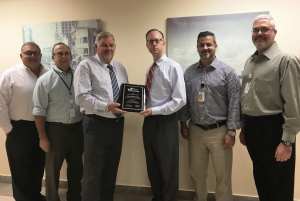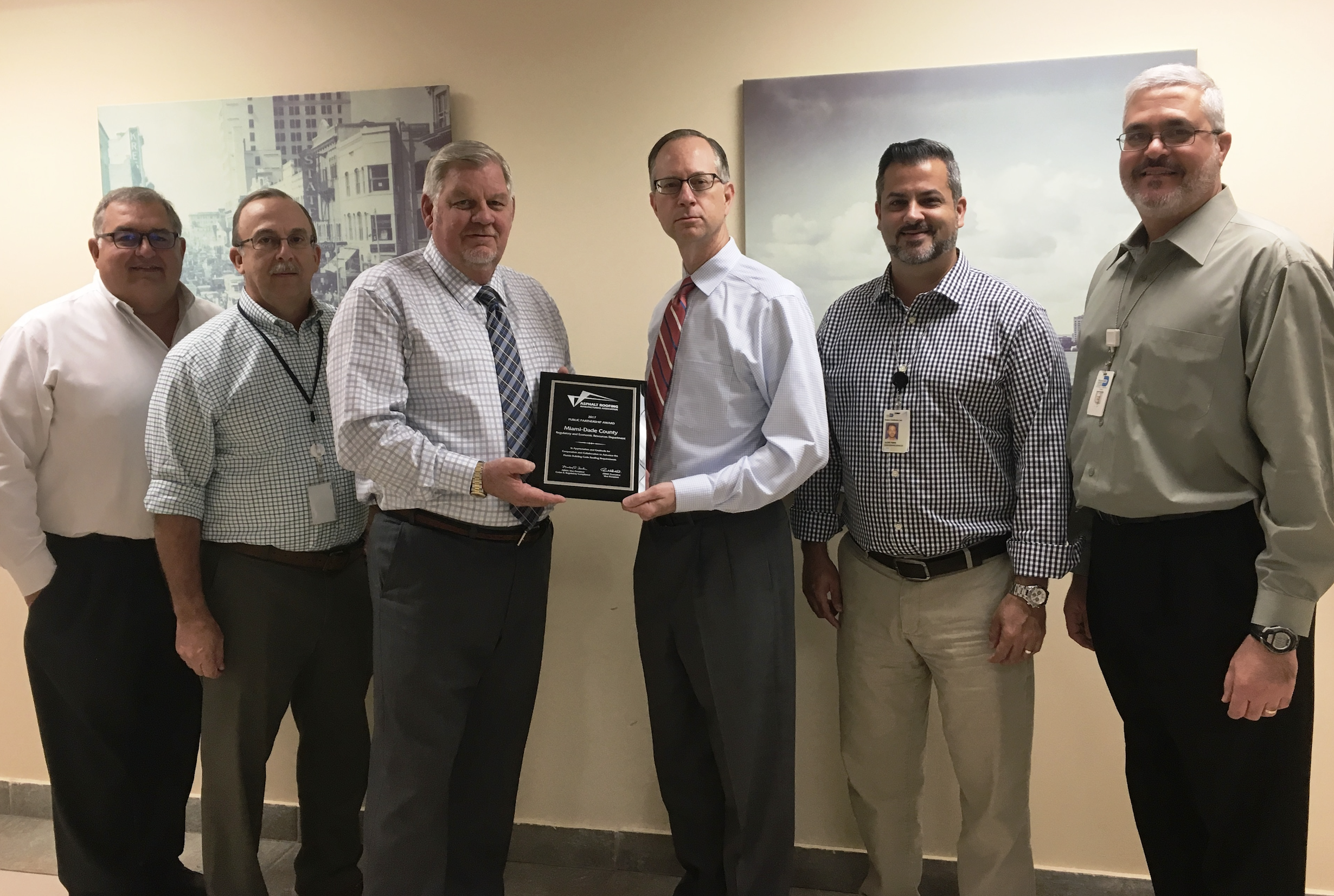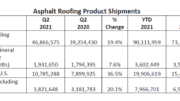
ARMA awarded the Miami-Dade Regulatory and Economic Resources Department the 2017 ARMA Public Partnership Award. Aaron R. Phillips, Corporate Director of Technical Services at TAMKO Building Products and chair of the ARMA Codes Steering Group, presented the award to Michael Goolsby and Miami-Dade team members who worked on the project. Pictured at the ceremony are (from left) Eduardo Fernandez, Gaspar Rodriguez, Michael Goolsby, Aaron Phillips, Alex Tigera and Jorge Acebo.
Two-and-a-half years later, their work is complete. The 2017 Florida Building Code is scheduled for implementation on Jan. 1, 2018, and it will include every one of the proposals and public comments jointly submitted by ARMA and Miami-Dade. As a result of this successful collaboration, ARMA presented the Miami-Dade Regulatory and Economic Resources Department with the inaugural ARMA Public Partnership Award in 2017 for their work together in updating the building codes for the HVHZ.
Members of the joint task force on the project shared their thoughts on the experience with Roofing, including Mike Fischer, ARMA’s Vice President of Codes & Regulatory Compliance; Michael Goolsby, Miami-Dade Board and Code Administration Division Director; Jorge Acebo, Roofing Product Control Examiner; Alex Tigera, Roofing Product Control Examiner; and Gaspar Rodriguez, Code Compliance and Training Officer, Roofing.
They all believe this collaboration between industry and government could serve as a successful model for other industry trade associations and other code bodies to follow. “This kind of cooperation between a public regulator and a private trade association is rare enough,” says Fischer. “The overwhelmingly positive results are unprecedented.”
The Problems
Miami-Dade staff and ARMA representatives both saw shortcomings in the roofing requirements for HVHZ. There were outdated references that needed to be removed, including test standards that were out of date. This often resulted in questions that slowed down the product approval review process. Members of the roofing industry also wanted to explore coordinating the Miami-Dade HVHZ protocols with other national testing requirements to further streamline testing procedures.
Fischer summed up ARMA’s goals this way: “ARMA is a responsible advocate for the asphalt roofing industry. We take that role seriously. We are an advocate. Our job is to represent the collective interests of the producers, but we try to be responsible about it. And it’s that drive to be responsible which led us to this partnership with the Miami-Dade staff.”
At the first meeting between ARMA and Miami-Dade, Fischer tried to break the ice. “The first thing we said when we came into that meeting was, ‘Hi, we’re from industry and we’re here to help,’” Fischer recalls. “I will tell you that when we started that meeting in the morning, the Miami-Dade staff was probably skeptical of what we were there for. By the end of the day, we had laid out a project plan of how we were going to work together, and that set the tone for the rest of the project.”
Fischer knew it would take the two entities working together to get things done. “In the Florida process, we knew we had to work with Miami-Dade, as they are a key stakeholder. We brought in other roof covering manufacturers for some of the discussions, and we also talked to the FRSA, the Florida Roofing and Sheet Metal Association—the contractors—so they were at the table for quite a bit of this as well.”
ARMA set up a special task group to focus on the Miami-Dade protocols. The task force went through documents one by one with members of Miami-Dade group, identifying problems and sections that were out of date. They hashed out compromises when they didn’t agree.
Protecting the Public
Goolsby worked on the project on behalf of Miami-Dade along with members of his team including Acebo, Tigera and Rodriguez. “We cover a lot of territory,” notes Goolsby. “We maintain the building code and write the building code, but we also oversee all of the contractor licensing in Miami-Dade County. We have about 15,000 local licensed contractors. Of course, we handle product approvals, and we also service all of the boards here. We have a board of rules and appeals. We also oversee 35 building departments throughout Miami-Dade County. We try to make sure the code is uniformly enforced in all of those jurisdictions. So, we cover a lot of bases.”
The top priority is protecting the public. “In a general sense, we provide for the health, safety and welfare of the public,” Goolsby says, “But it’s these issues of life safety that are the most critical.”
Evacuating South Florida is difficult, so the residential portions of the code were written under the assumption that many people might have to ride out a storm in their homes. “We wanted their home to be just as strong as any commercial structure,” says Goolsby.
Acebo notes that ensuring the code is properly followed is as crucial as the code itself. He believes the inspectors’ role includes reassuring homeowners that systems are being installed correctly. “It’s important to us to fulfill our role to provide independent corroboration that the work is being done and installed properly,” he says. “The great thing about this particular effort is that it was truly collaborative. It was great to work with them and establish the language that was common with other jurisdictions or other certification agencies.”
Promising Results
Members of the joint task force agree that the changes make the code easier to understand. They also should streamline product approvals process.
“These updates definitely help the manufacturers get through the product approval process, specifically for Miami-Dade HVHZ requirements,” Fischer states. “It also helps the roofing contractor because we made sure the documents have the installation language updated, so it gives better direction to the installers of the products. And that trickles up to the general contractors in new construction, as it speeds up their processes and takes out some burdens.”
“At the end of the day, as a responsible advocate, one of ARMA’s main motivators was to make sure their industry’s products get installed the way they are intended to be installed,” Fischer continues. “That benefits the end user—the building owner and building occupant.”
Acebo agrees that the approvals process helps everyone—homeowners, contractors, manufacturers and inspectors. “If questions come out of the field from homeowners, manufacturers or contractors as to whether something is being applied or used properly, we can serve as that independent third party that doesn’t really have a stake in it other than to serve as an arbitrator who can clearly indicate whether something is right or not according to what has been provided and tested.”
The collaboration was so successful that the task force is already looking at other changes in the future. The Miami-Dade code is used as a model for other code bodies, and the joint task force could serve in that role as well, according to Fischer. “This is a model of collaboration between a governmental agency and private industry groups that will serve us well,” he says. “We are going to continue to do this with other groups, and frankly we’re going to continue doing it with Miami-Dade because this process isn’t ever done. Things will always be changing and we always have to keep up to date.”





Be the first to comment on "Miami-Dade County and ARMA Team Up to Update High-Wind Codes"